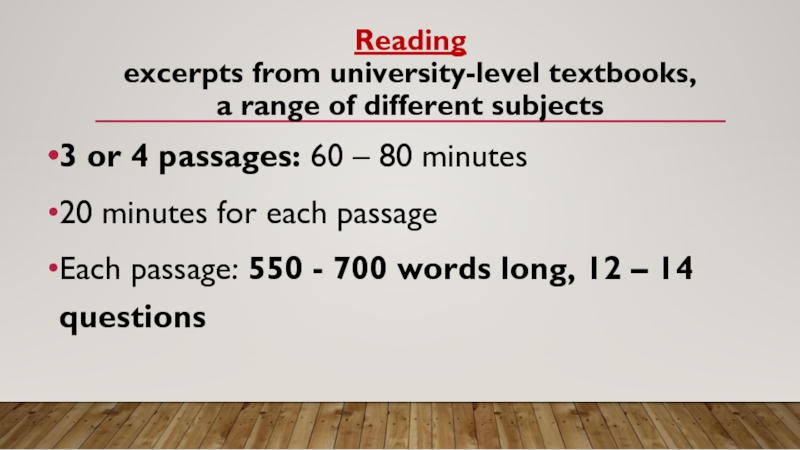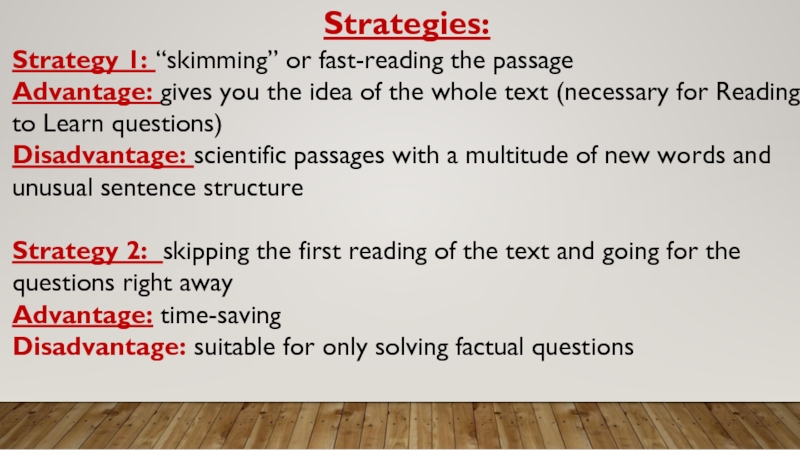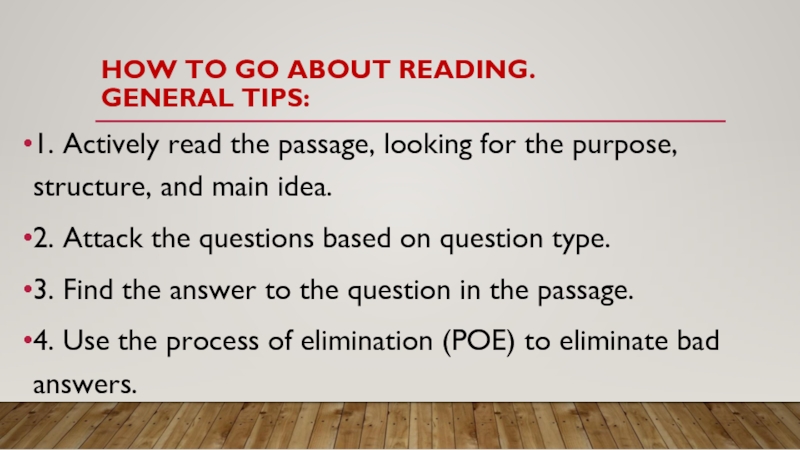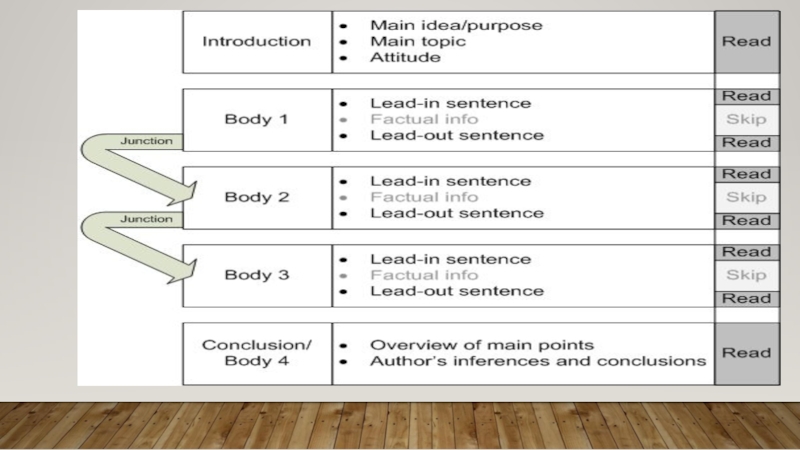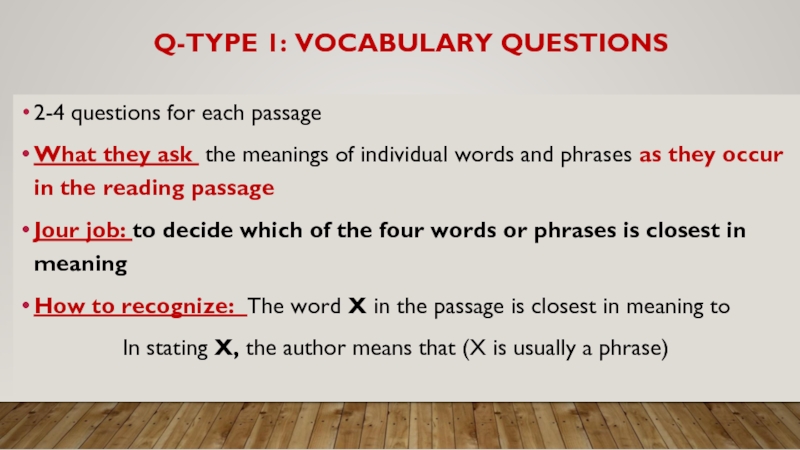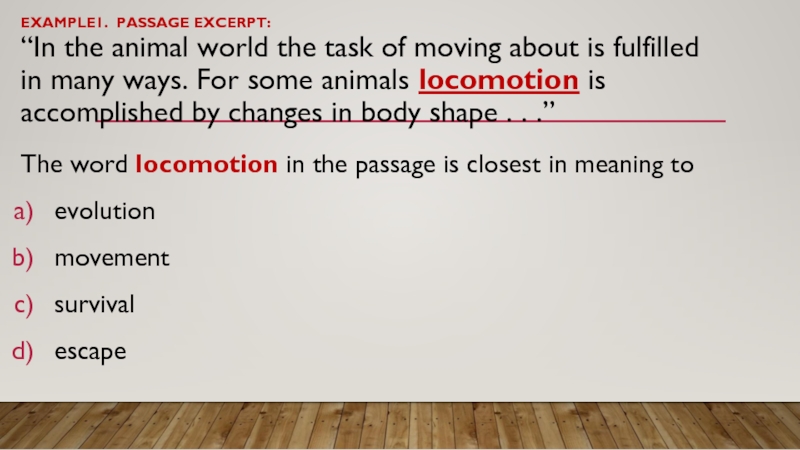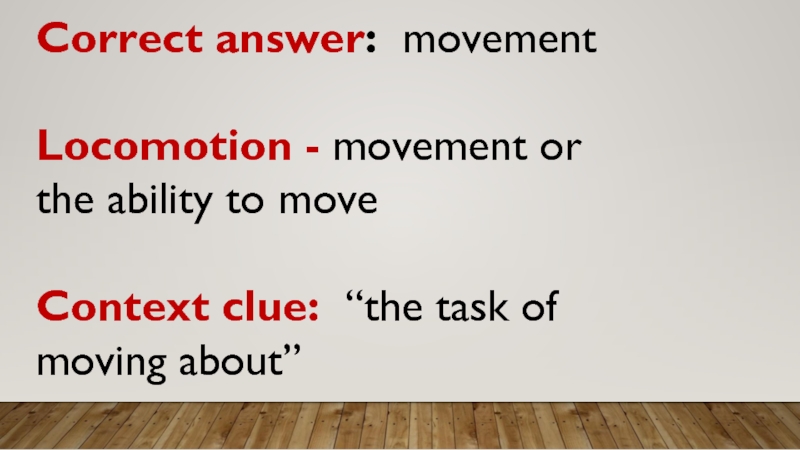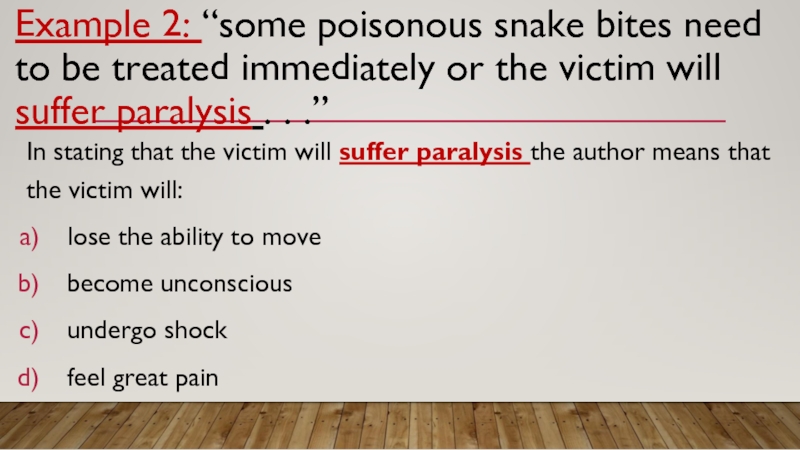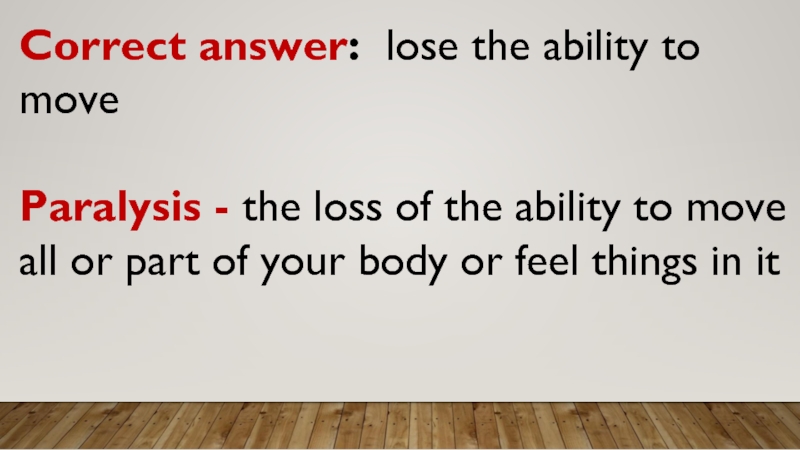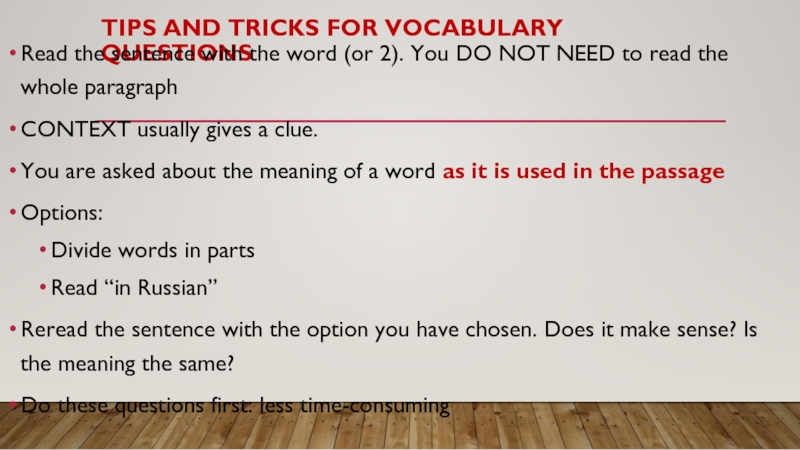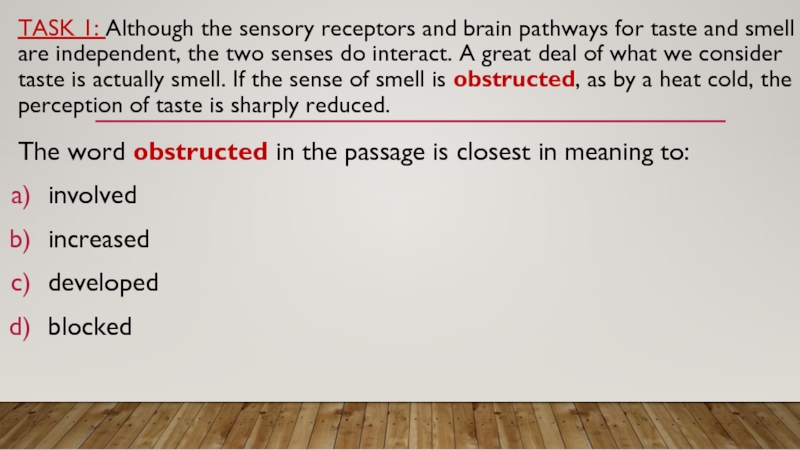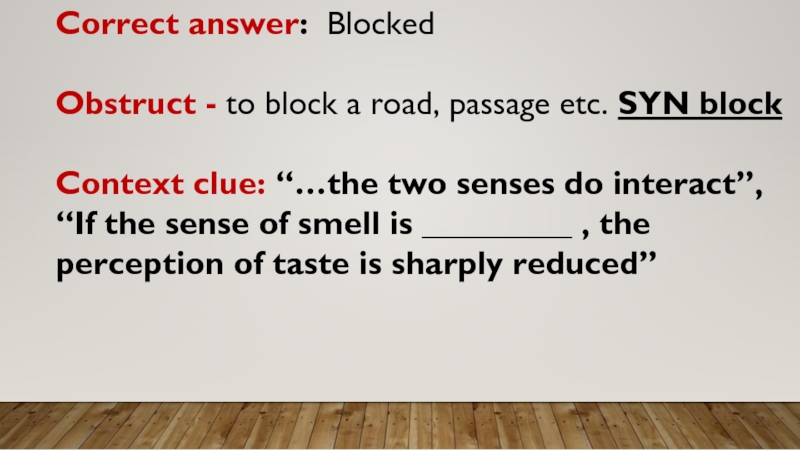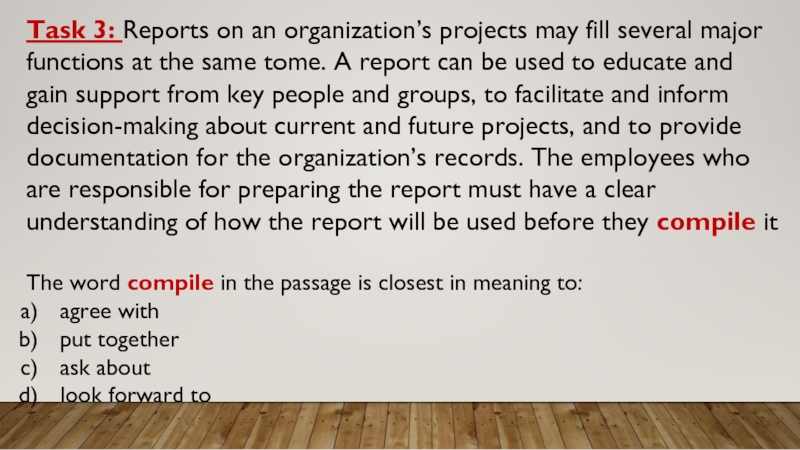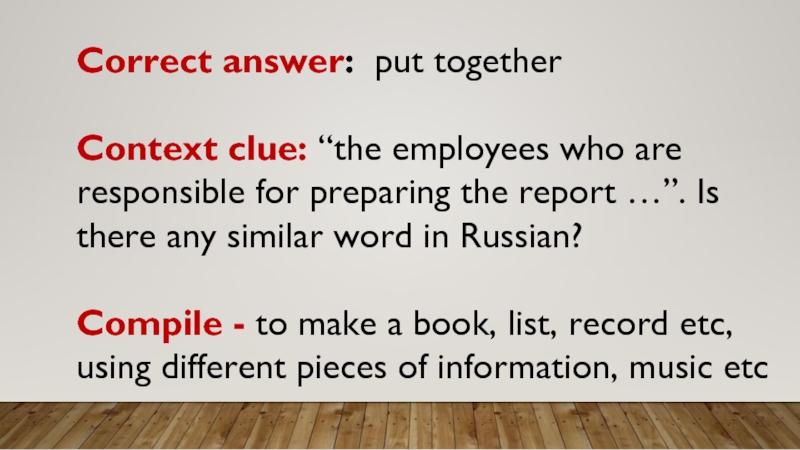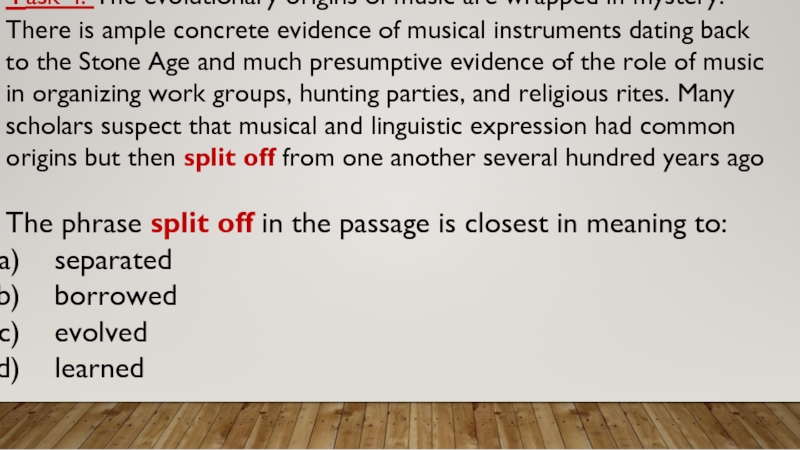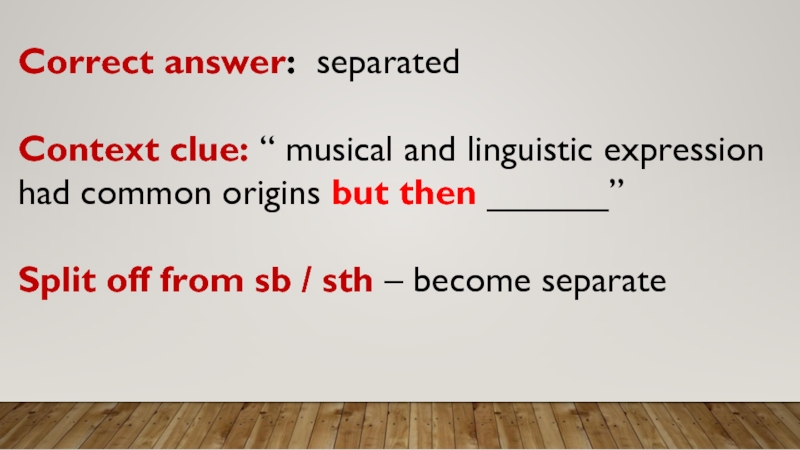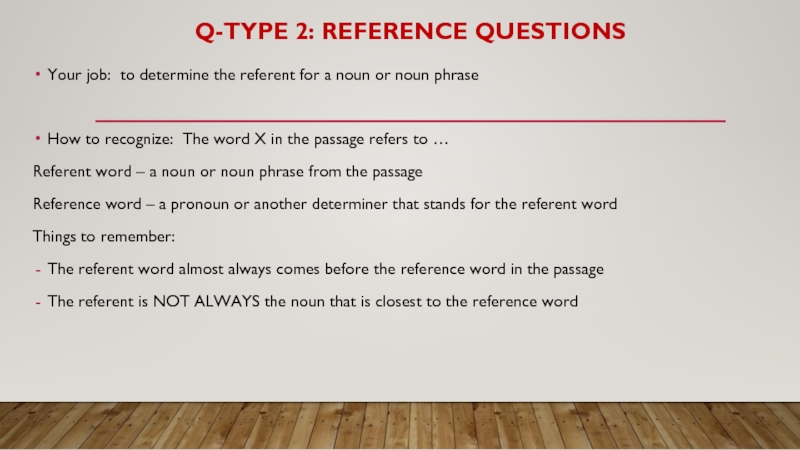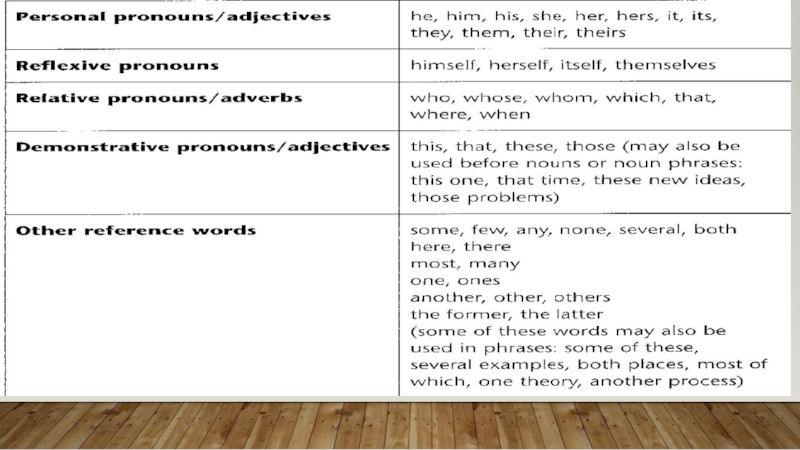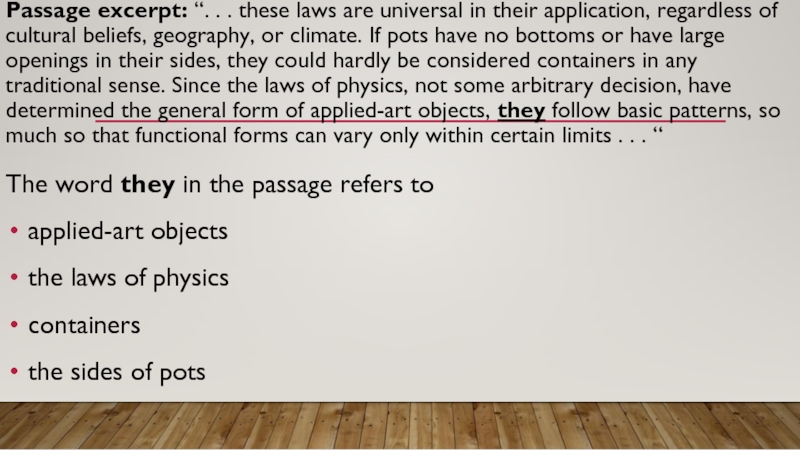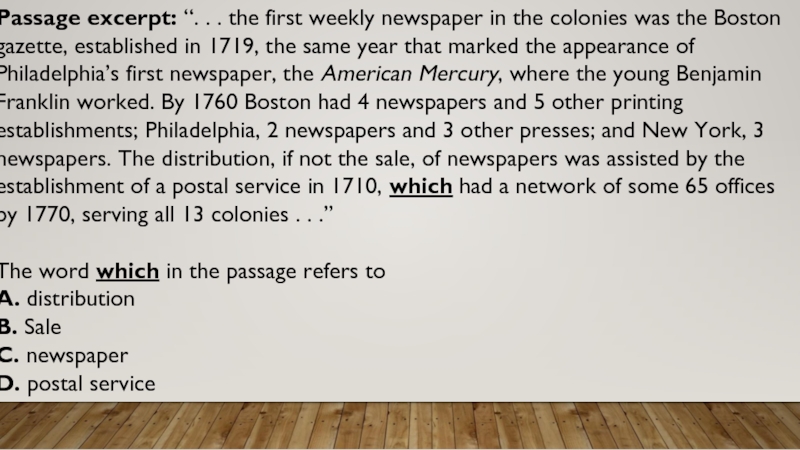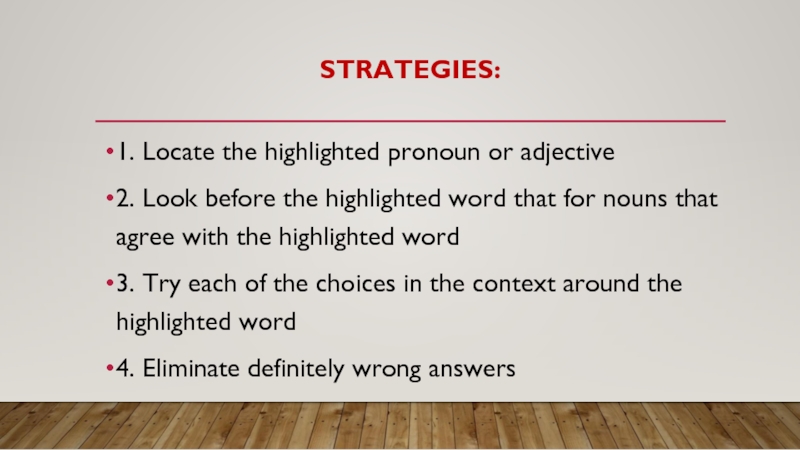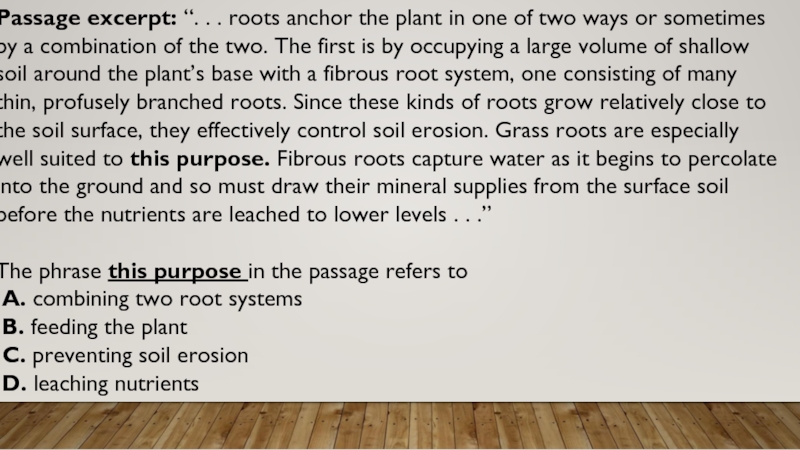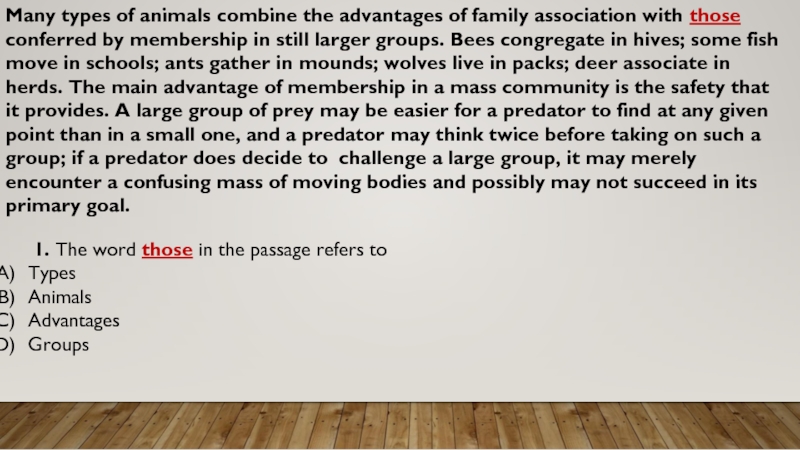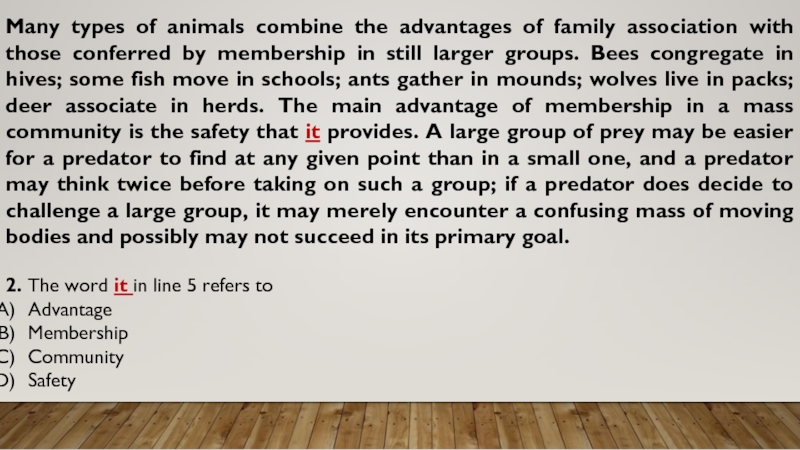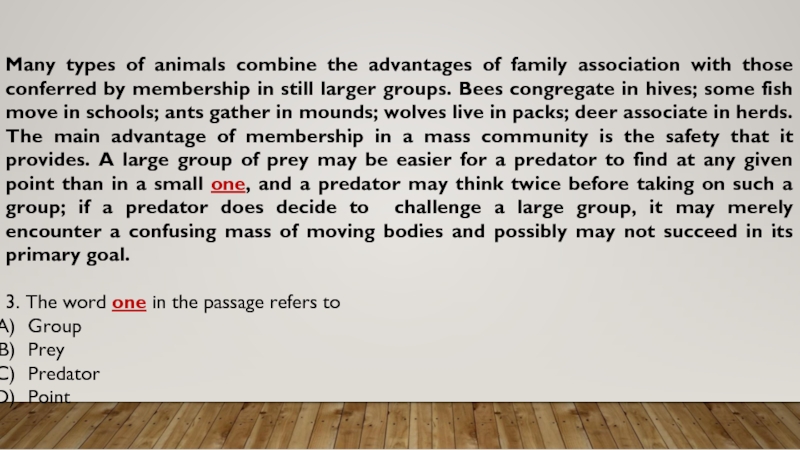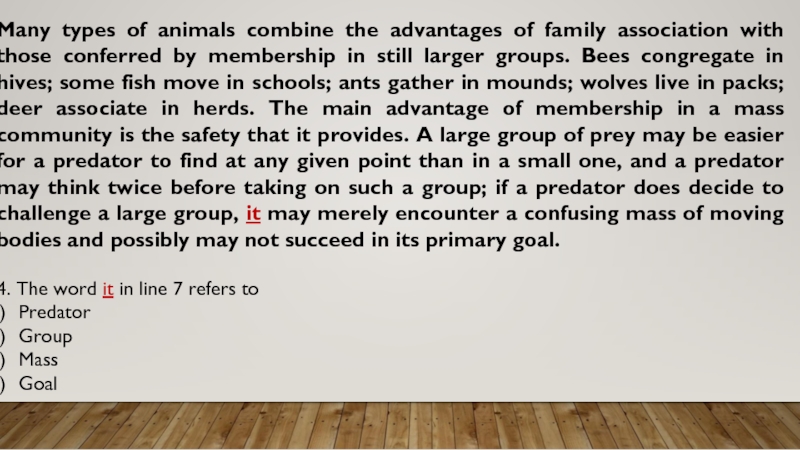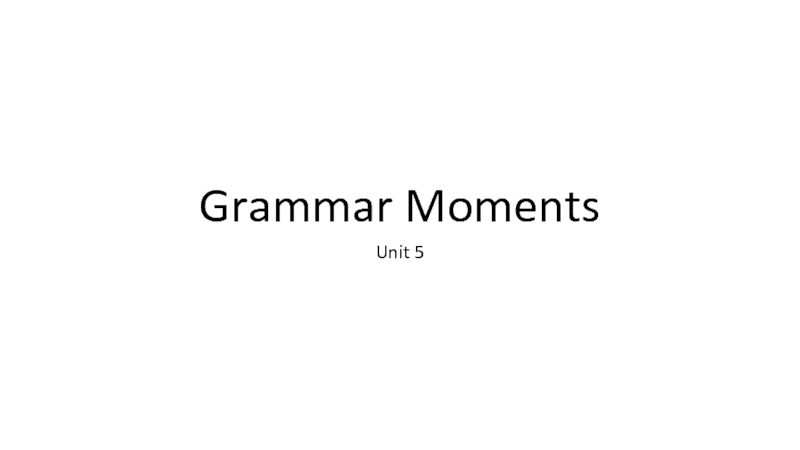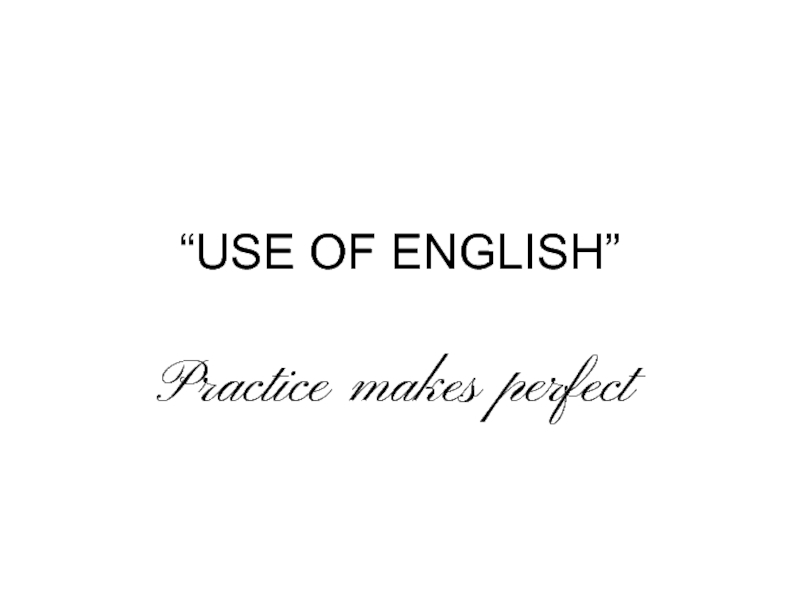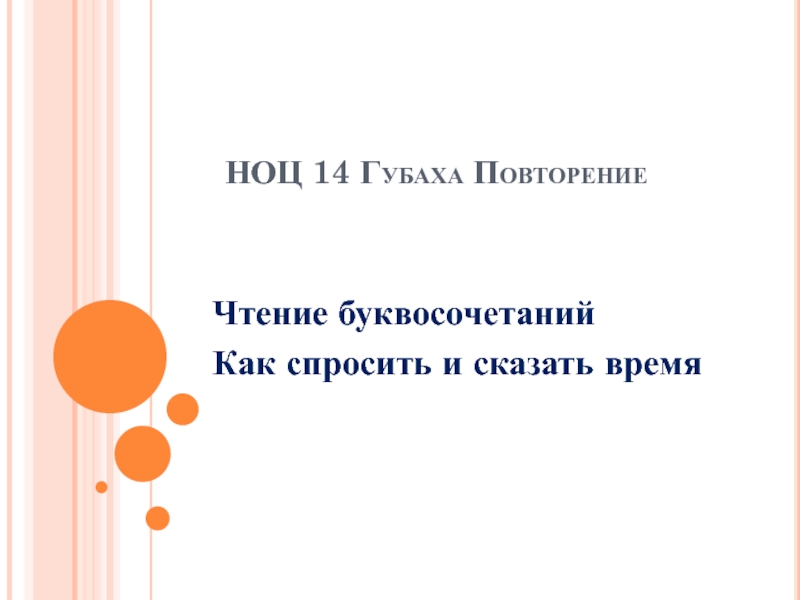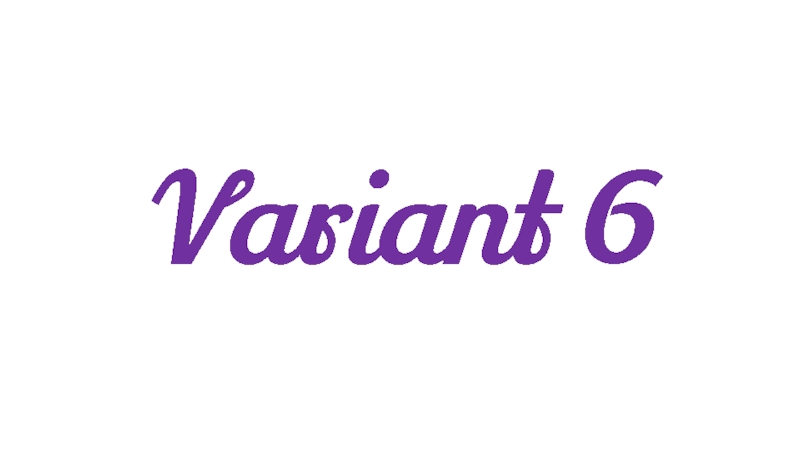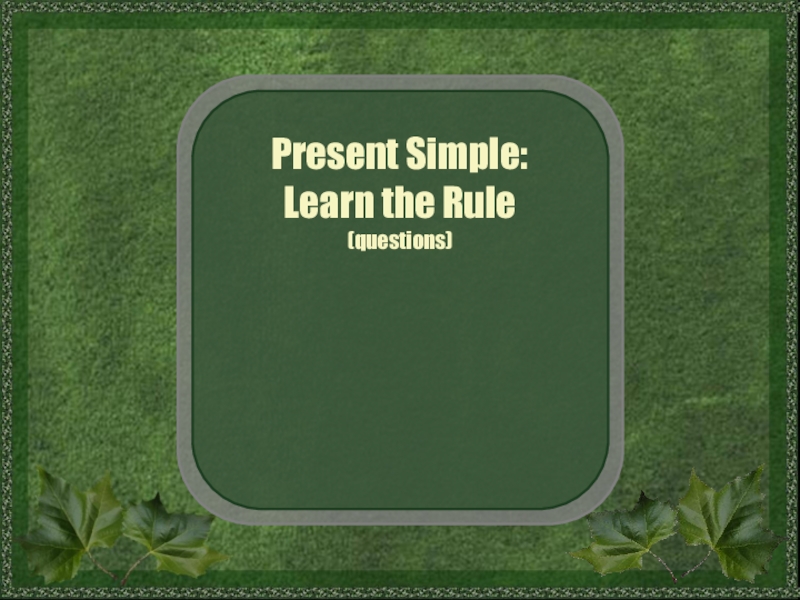- Главная
- Разное
- Дизайн
- Бизнес и предпринимательство
- Аналитика
- Образование
- Развлечения
- Красота и здоровье
- Финансы
- Государство
- Путешествия
- Спорт
- Недвижимость
- Армия
- Графика
- Культурология
- Еда и кулинария
- Лингвистика
- Английский язык
- Астрономия
- Алгебра
- Биология
- География
- Детские презентации
- Информатика
- История
- Литература
- Маркетинг
- Математика
- Медицина
- Менеджмент
- Музыка
- МХК
- Немецкий язык
- ОБЖ
- Обществознание
- Окружающий мир
- Педагогика
- Русский язык
- Технология
- Физика
- Философия
- Химия
- Шаблоны, картинки для презентаций
- Экология
- Экономика
- Юриспруденция
TOEFL reading презентация
Содержание
- 1. TOEFL reading
- 2. Reading excerpts from university-level textbooks, a
- 3. Strategies: Strategy 1: “skimming” or fast-reading the
- 4. HOW TO GO ABOUT READING. GENERAL
- 6. Q-TYPE 1: VOCABULARY QUESTIONS 2-4 questions
- 7. EXAMPLE1. PASSAGE EXCERPT: “In the animal
- 8. Correct answer: movement Locomotion - movement
- 9. Example 2: “some poisonous snake bites need
- 10. Correct answer: lose the ability to move
- 11. TIPS AND TRICKS FOR VOCABULARY QUESTIONS Read
- 12. TASK 1: Although the sensory receptors and
- 13. Correct answer: Blocked Obstruct - to
- 14. Task 2: A water molecule consists of
- 15. Correct answer: explains Account for -to be the reason why something happens SYN explain
- 16. Task 3: Reports on an organization’s projects
- 17. Correct answer: put together Context clue:
- 18. Task 4: The evolutionary origins of music
- 19. Correct answer: separated Context clue: “
- 20. Q-TYPE 2: REFERENCE QUESTIONS Your job: to
- 22. Passage excerpt: “. . . these
- 23. Passage excerpt: “. . . the first
- 24. STRATEGIES: 1. Locate the highlighted pronoun
- 25. Passage excerpt: “. . . roots anchor
- 26. Many types of animals combine the advantages
- 27. Many types of animals combine the advantages
- 28. Many types of animals combine the advantages
- 29. Many types of animals combine the advantages
Слайд 2Reading
excerpts from university-level textbooks,
a range of different subjects
3 or 4
20 minutes for each passage
Each passage: 550 - 700 words long, 12 – 14 questions
Слайд 3Strategies:
Strategy 1: “skimming” or fast-reading the passage
Advantage: gives you the idea
Disadvantage: scientific passages with a multitude of new words and unusual sentence structure
Strategy 2: skipping the first reading of the text and going for the questions right away
Advantage: time-saving
Disadvantage: suitable for only solving factual questions
Слайд 4HOW TO GO ABOUT READING.
GENERAL TIPS:
1. Actively read the passage,
2. Attack the questions based on question type.
3. Find the answer to the question in the passage.
4. Use the process of elimination (POE) to eliminate bad answers.
Слайд 6Q-TYPE 1: VOCABULARY QUESTIONS
2-4 questions for each passage
What they ask
Jour job: to decide which of the four words or phrases is closest in meaning
How to recognize: The word X in the passage is closest in meaning to
In stating X, the author means that (X is usually a phrase)
Слайд 7EXAMPLE1. PASSAGE EXCERPT: “In the animal world the task of moving
The word locomotion in the passage is closest in meaning to
evolution
movement
survival
escape
Слайд 8Correct answer: movement
Locomotion - movement or the ability to move
Context clue:
Слайд 9Example 2: “some poisonous snake bites need to be treated immediately
In stating that the victim will suffer paralysis the author means that the victim will:
lose the ability to move
become unconscious
undergo shock
feel great pain
Слайд 10Correct answer: lose the ability to move
Paralysis - the loss of
Слайд 11TIPS AND TRICKS FOR VOCABULARY QUESTIONS
Read the sentence with the word
CONTEXT usually gives a clue.
You are asked about the meaning of a word as it is used in the passage
Options:
Divide words in parts
Read “in Russian”
Reread the sentence with the option you have chosen. Does it make sense? Is the meaning the same?
Do these questions first: less time-consuming
Слайд 12TASK 1: Although the sensory receptors and brain pathways for taste
The word obstructed in the passage is closest in meaning to:
involved
increased
developed
blocked
Слайд 13Correct answer: Blocked
Obstruct - to block a road, passage etc. SYN block
Context
Слайд 14Task 2: A water molecule consists of two hydrogen atoms attached
The phrase accounts for in the passage means:
explains
decreases
connects
summarizes
Слайд 16Task 3: Reports on an organization’s projects may fill several major
The word compile in the passage is closest in meaning to:
agree with
put together
ask about
look forward to
Слайд 17Correct answer: put together
Context clue: “the employees who are responsible for
Compile - to make a book, list, record etc, using different pieces of information, music etc
Слайд 18Task 4: The evolutionary origins of music are wrapped in mystery.
The phrase split off in the passage is closest in meaning to:
separated
borrowed
evolved
learned
Слайд 19Correct answer: separated
Context clue: “ musical and linguistic expression had common
Split off from sb / sth – become separate
Слайд 20Q-TYPE 2: REFERENCE QUESTIONS
Your job: to determine the referent for a
How to recognize: The word X in the passage refers to …
Referent word – a noun or noun phrase from the passage
Reference word – a pronoun or another determiner that stands for the referent word
Things to remember:
The referent word almost always comes before the reference word in the passage
The referent is NOT ALWAYS the noun that is closest to the reference word
Слайд 22 Passage excerpt: “. . . these laws are universal in their
The word they in the passage refers to
applied-art objects
the laws of physics
containers
the sides of pots
Слайд 23Passage excerpt: “. . . the first weekly newspaper in the
The word which in the passage refers to
A. distribution
B. Sale
C. newspaper
D. postal service
Слайд 24STRATEGIES:
1. Locate the highlighted pronoun or adjective
2. Look before the
3. Try each of the choices in the context around the highlighted word
4. Eliminate definitely wrong answers
Слайд 25Passage excerpt: “. . . roots anchor the plant in one
The phrase this purpose in the passage refers to
A. combining two root systems
B. feeding the plant
C. preventing soil erosion
D. leaching nutrients
Слайд 26Many types of animals combine the advantages of family association with
1. The word those in the passage refers to
Types
Animals
Advantages
Groups
Слайд 27Many types of animals combine the advantages of family association with
2. The word it in line 5 refers to
Advantage
Membership
Community
Safety
Слайд 28Many types of animals combine the advantages of family association with
3. The word one in the passage refers to
Group
Prey
Predator
Point
Слайд 29Many types of animals combine the advantages of family association with
4. The word it in line 7 refers to
Predator
Group
Mass
Goal

